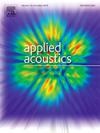Lattice-structured, microperforated panel with high perforation ratio for broadband sound absorber
IF 3.4
2区 物理与天体物理
Q1 ACOUSTICS
引用次数: 0
Abstract
A microperforated panel (MPP), in the form of a distributed Helmholtz resonator, has submillimeter holes on a planar panel, inducing high sound absorption at a single peak within a narrow frequency range. However, broadening the bandwidth and reducing the volume of an MPP to the subwavelength scale is necessary to expand its application in room acoustics, transport, and aerospace engineering industries. In this work, we propose a lattice-structured MPP (LMPP) with a smaller perforation size and higher perforation ratio, which demonstrates high absorption performance at the subwavelength scale. By tuning the material flow rate in a fused deposition modeling-type three-dimensional printing process, LMPPs were easily fabricated with a small perforation of 0.05 ∼ 0.4 mm in square configuration and a perforation ratio range of 0.65 ∼ 41.50 %. The fabricated LMPP showed a high sound absorption coefficient (α > 0.9) with a wider bandwidth at mid- and high-frequencies (800–4,000 Hz) owing to the lower resistance and better impedance matching on the panel surfaces. Furthermore, inhomogeneous LMPPs (iLMPPs) were fabricated by arranging LMPPs with different perforation sizes in parallel. Owing to the overlapping effect of the resonance peaks of each sub-LMPP, iLMPP exhibited broad absorption characteristic of the effective absorption bandwidth over 4,635 Hz at the first peak frequency of 2,234 Hz, resulting in an overall subwavelength (<λ/10) thickness of 11 mm. The additively fabricated LMPPs exhibited strong advantages with easy tuning of the perforation geometry or distribution, which could be effective for various applications requiring smaller volumes or complex geometries.

求助全文
约1分钟内获得全文
求助全文
来源期刊

Applied Acoustics
物理-声学
CiteScore
7.40
自引率
11.80%
发文量
618
审稿时长
7.5 months
期刊介绍:
Since its launch in 1968, Applied Acoustics has been publishing high quality research papers providing state-of-the-art coverage of research findings for engineers and scientists involved in applications of acoustics in the widest sense.
Applied Acoustics looks not only at recent developments in the understanding of acoustics but also at ways of exploiting that understanding. The Journal aims to encourage the exchange of practical experience through publication and in so doing creates a fund of technological information that can be used for solving related problems. The presentation of information in graphical or tabular form is especially encouraged. If a report of a mathematical development is a necessary part of a paper it is important to ensure that it is there only as an integral part of a practical solution to a problem and is supported by data. Applied Acoustics encourages the exchange of practical experience in the following ways: • Complete Papers • Short Technical Notes • Review Articles; and thereby provides a wealth of technological information that can be used to solve related problems.
Manuscripts that address all fields of applications of acoustics ranging from medicine and NDT to the environment and buildings are welcome.
 求助内容:
求助内容: 应助结果提醒方式:
应助结果提醒方式:


